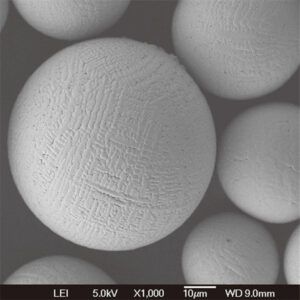Plasma Rotating Electrode Process Powder Tổng quan
The plasma rotating electrode process (PREP) is a unique powder production technique that utilizes a rotating electrode to generate a plasma arc. This arc melts and atomizes the electrode material, creating spherical metal powder particles with exceptional properties. PREP powders are widely used in additive manufacturing, powder metallurgy, and thermal spraying applications.

Types, Composition, and Properties of PREP Powders
| Kiểu | Thành phần | Của cải |
|---|---|---|
| Titan | Titanium, alloying elements | High strength, low density, and corrosion resistance |
| Nickel-based | Nickel, chromium, cobalt, alloying elements | Corrosion resistance, high-temperature strength, and wear resistance |
| Cobalt-based | Cobalt, chromium, tungsten, alloying elements | High hardness, wear resistance, and corrosion resistance |
| Thép không gỉ | Iron, chromium, nickel, alloying elements | Corrosion resistance, high strength, and toughness |
| Nhôm | Aluminum, alloying elements | Lightweight, high strength-to-weight ratio, and corrosion resistance |
| Đồng | Copper, alloying elements | High electrical and thermal conductivity, corrosion resistance |
| Vonfram | Tungsten, alloying elements | High melting point, high density, and wear resistance |
| Molypden | Molybdenum, alloying elements | High strength, high-temperature strength, and corrosion resistance |
| Tantalum | Tantalum, alloying elements | High melting point, high density, and corrosion resistance |
Applications of PREP Powders
| Ứng dụng | Ngành công nghiệp | Những lợi ích |
|---|---|---|
| sản xuất phụ gia | Aerospace, automotive, medical | Complex geometries, lightweight components, rapid prototyping |
| Powder metallurgy | Automotive, electronics, tooling | High precision, near-net-shape components, reduced waste |
| Thermal spraying | Aerospace, automotive, energy | Protective coatings, wear resistance, corrosion resistance |
| Friction stir welding | Aerospace, automotive, shipbuilding | High-strength welds, reduced distortion, improved fatigue life |
| Đúc kim loại | Electronics, medical, automotive | Complex geometries, high-volume production, near-net-shape components |
Specifications, Sizes, Grades, and Standards of PREP Powders
| Sự chỉ rõ | Sự miêu tả |
|---|---|
| Size | Particle diameter range (e.g., 10-100 microns) |
| Cấp | Purity level, alloy composition |
| Tiêu chuẩn | International or industry-specific standards (e.g., ASTM, ISO) |
Suppliers and Pricing of PREP Powders
| Nhà cung cấp | Vị trí | Phạm vi giá |
|---|---|---|
| Höganäs | Thụy Điển | $100-$350 per kilogram |
| Sandvik | Thụy Điển | $120-$360 per kilogram |
| Ap & amp; c | Hoa Kỳ | $150-$450 per kilogram |
| GKN | Vương quốc Anh | $125-$370 per kilogram |
| Công nghệ thợ mộc | Hoa Kỳ | $130-$380 per kilogram |
| MET3DP | Trung Quốc | $80-$190 per kilogram |
Advantages and Disadvantages of PREP Powders
Advantages:
- High purity and consistency
- Spherical shape for optimal packing and flowability
- Wide range of materials and alloys available
- Excellent mechanical properties
- Reduced waste and environmental impact
Disadvantages:
- Can be more expensive than other powder production methods
- Requires specialized equipment and expertise
- May require post-processing to achieve desired properties
Câu hỏi thường gặp
| Question | Answer |
|---|---|
| What is the difference between PREP powders and gas atomized powders? | PREP powders are typically finer and more spherical than gas atomized powders. |
| What are the key factors to consider when selecting PREP powders? | Size, grade, composition, and supplier reliability. |
| How can I ensure the quality of PREP powders? | By purchasing from reputable suppliers and conducting thorough testing. |
| What are the emerging applications of PREP powders? | Additive manufacturing, advanced coatings, and lightweight materials. |
| How can I learn more about PREP powders? | Attend industry conferences, read technical papers, and consult with experts. |








